Description
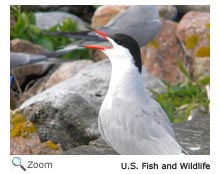 The common tern is
12-15
inches in length with a wingspan of 30-31 inches. It has a white breast and undersides and a slate gray back and upperwings. It has a black cap on its head and orange-red legs and feet. It has a pointed, bright orange bill with a black tip and a forked tail. Males and females look alike. The common tern is
12-15
inches in length with a wingspan of 30-31 inches. It has a white breast and undersides and a slate gray back and upperwings. It has a black cap on its head and orange-red legs and feet. It has a pointed, bright orange bill with a black tip and a forked tail. Males and females look alike.
Range 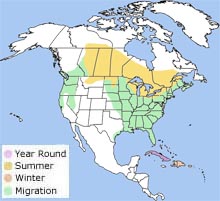 The common tern breeds
from Alberta, Canada east to Labrador, Canada and south to Montana, the Great Lakes and the Atlantic coast. It winters from Florida south to
the Caribbean and South America.
The common tern is also found in Africa, Europe, Asia, and Australia. The common tern breeds
from Alberta, Canada east to Labrador, Canada and south to Montana, the Great Lakes and the Atlantic coast. It winters from Florida south to
the Caribbean and South America.
The common tern is also found in Africa, Europe, Asia, and Australia.
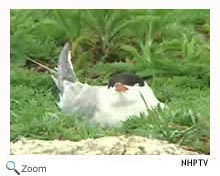 In New Hampshire, the common tern breeds on the Isles of Shoals.
By the early 1950s, the common tern population on New Hampshire's Isles of Shoals had disappeared. Hunting and competition and predation from a growing American herring gull population had destroyed the common tern population that had bred on the islands for hundreds of years. In New Hampshire, the common tern breeds on the Isles of Shoals.
By the early 1950s, the common tern population on New Hampshire's Isles of Shoals had disappeared. Hunting and competition and predation from a growing American herring gull population had destroyed the common tern population that had bred on the islands for hundreds of years.
 In 1997, the
Audubon Society of New Hampshire and the NH Fish and Game Department
began creating safe nesting sites for the common tern on White and Seavey Islands. The safe nesting sites use decoys and other non-lethal tools to drive away sea gulls! In the first year of the project six pairs nested. Today there are over 2,500 nesting pairs of common terns on the Isles of Shoals. The safe nesting place has also attracted some roseate tern and arctic tern pairs! In 1997, the
Audubon Society of New Hampshire and the NH Fish and Game Department
began creating safe nesting sites for the common tern on White and Seavey Islands. The safe nesting sites use decoys and other non-lethal tools to drive away sea gulls! In the first year of the project six pairs nested. Today there are over 2,500 nesting pairs of common terns on the Isles of Shoals. The safe nesting place has also attracted some roseate tern and arctic tern pairs!
| |
Habitat
The common tern is found on islands, marshes, lakes, ponds, rivers, and beaches.
Diet
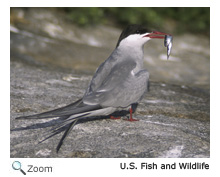 The common tern eats small fish. It flies over the water and then plunges below the surface to snatch up its prey. It occasionally eats
crustaceans and insects. The common tern eats small fish. It flies over the water and then plunges below the surface to snatch up its prey. It occasionally eats
crustaceans and insects.
Life Cycle
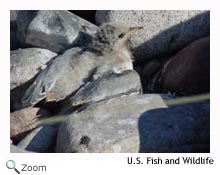 The common tern nests in colonies.
The male selects a breeding territory and protects it. He courts a female by bringing her a fish! The male mates with only one female. The nest
is a pile of dead vegetation placed on sandy or rocky beaches or on rocky ground. The female lays 1-4 eggs, and the male and the female incubate the eggs for 20-26 days. Both parents care for and feed the chicks and aggressively protect them from predators by
diving at intruders and striking them with their bills
The chicks fledge when they are 27-30 days old. The common tern mates when it is three years old. The common tern nests in colonies.
The male selects a breeding territory and protects it. He courts a female by bringing her a fish! The male mates with only one female. The nest
is a pile of dead vegetation placed on sandy or rocky beaches or on rocky ground. The female lays 1-4 eggs, and the male and the female incubate the eggs for 20-26 days. Both parents care for and feed the chicks and aggressively protect them from predators by
diving at intruders and striking them with their bills
The chicks fledge when they are 27-30 days old. The common tern mates when it is three years old.
Behavior
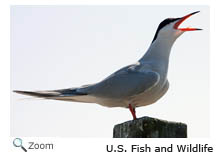 The common tern population has been declining due to habitat loss and nest disturbance. Their nests are often difficult to see on beaches and their eggs can be easily destroyed by people stepping on the them. The common tern is a threatened species in New Hampshire. The common tern population has been declining due to habitat loss and nest disturbance. Their nests are often difficult to see on beaches and their eggs can be easily destroyed by people stepping on the them. The common tern is a threatened species in New Hampshire.
|

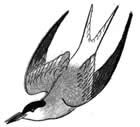

 The common tern breeds
from Alberta, Canada east to Labrador, Canada and south to Montana, the Great Lakes and the Atlantic coast. It winters from Florida south to
the Caribbean and South America.
The common tern is also found in Africa, Europe, Asia, and Australia.
The common tern breeds
from Alberta, Canada east to Labrador, Canada and south to Montana, the Great Lakes and the Atlantic coast. It winters from Florida south to
the Caribbean and South America.
The common tern is also found in Africa, Europe, Asia, and Australia. 



